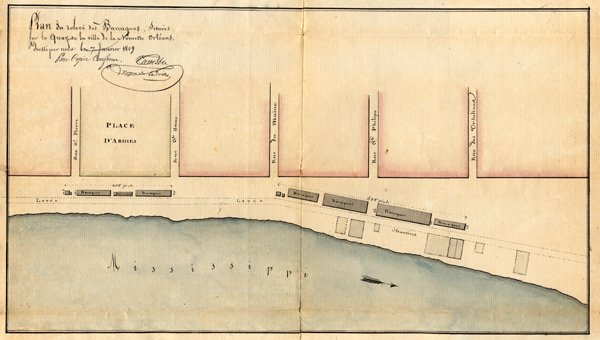
| ||
| Return to Table of Contents Go to Page [1] [2] [3] [4] [5] [6] [7] [8] [9] [10] [11] [12] [13] [14] [15] [16] [17] [18] [19] [20] [21] [22] [23] [24] [25] [26] [27] [28] [29] [30] [31] [32] [33] [34] [35] [36] [37] [38] [39] [40] [41] [42] [43] [44] [45] [46] [47] [48] [49] [50] [51] | ||
PAGE 32
| This plan, filed in the Superior Court
case
The Mayor, Alderman and Inhabitants of New Orleans v. John Marie Henry, Philip Harty, et al. shows
a portion of the riverfront opposite the Place d'Armes, the present day Jackson Square. In this suit, Henry,
Harty and 19 others were taken to court by the City, which had in July, 1805 ordered that the huts
(barraques), cabins, houses and buildings on the levee in front of the city be demolished since they had
become "a great nuisance to the hindrance and annoyance of passengers as well as to the injury of the
health and good Police of said City." The right to use the buildings on the levee had been granted by the
Spanish Cabildo "during a time of great and peculiar distress in this city, from a fire which swept off a
number of houses" –presumably the fire of 1794. The City argued that use of the buildings had been granted
on the condition that the occupants would vacate them when requested to do so by the Cabildo and, since
the Conseil de Ville now held all the administrative rights that the Cabildo had once enjoyed, the plaintiff's
were bound by their conditional agreement to give up their possession of the levee buildings when asked to
do so.
| The issues in the case were complicated by the fact that the ownership of the land under the levee was claimed by both the City of New Orleans and the United States Government. The defendants argued that the City had no right to force them from the levee since the land was owned by the federal government. The United States' attorneys made it clear in their statement that they considered the land in question to belong to the federal government, but that they were willing to enforce the Council's decree that the buildings be vacated.
The case is interesting, not simply because of the map filed amongst its papers, but because it touches
upon some of the same issues of ownership of "public" land as the more famous "Batture Case," filed
several years later. 
|